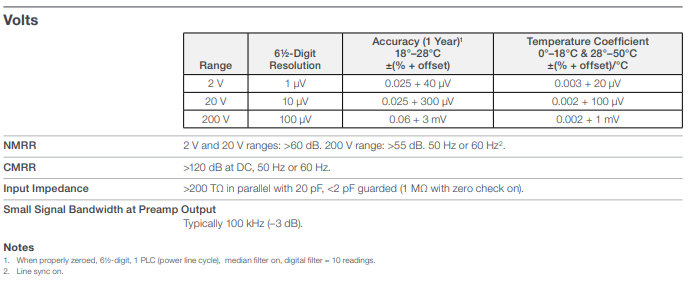

When searching for the right product, the firsthand guide to doing so is the product’s datasheet. Whether you are searching for a Digital Multimeter (DMM), a power supply, an oscilloscope, or any precision test and measurement instrument, you should consult the datasheet to ensure the instrument will meet your needs. But datasheets can be confusing if you’re not familiar with them.
What information is found in a datasheet?
Every datasheet contains documentation on the product’s capabilities, features, and performance specifications. The general sections are:
Key features
A datasheet will call out any unique or special capabilities to help you decide on one product over another. These might be related to the user experience, software options, or especially important specifications.
Typical use cases and applications
In this section, the manufacturer details the circumstances in which the product will be used. Ideally, clear examples are provided to help you determine whether or not the product can address your specific needs.
Performance Specifications
The specifications or ‘specs’ of an instrument are generally the main reason to check the datasheet. They quantitatively detail how you should expect an instrument to perform. The actual specifications that are included will vary depending on the instrument and manufacturer. Below is an example below of the Volts Specification from the 6517B Electrometer/High Resistance Meter datasheet. The specifications list the product’s resolution, range and accuracy along with specific notes on how to ensure proper measurement that will meet these specifications.
Also be sure to check the time period for which the performance specifications are valid. This is typically 1 year, but some products might say their specifications are valid for 2 or even 3 years. After that amount of time, you should not rely on your product still meeting the defined performance. You will need to have your product calibrated to re-verify the performance and start the count down again.
You may sometimes find specifications by themselves in a separate document; in most cases, either can be used as a specification reference as long as both are up to date. Always use the most recent datasheet when looking at products, as a manufacturer may change instrument specifications over time.
To learn more about reading instrument specifications, see Section 1.4 of the Keithley Low Level Measurements Handbook: About Instrument Specifications.

General Characteristics
Besides performance specifications, a datasheet will include non-performance specifications, too. These can include the weight, power draw and many other miscellaneous but important features. Given below is an example from the DMM6500 Datasheet, which lists the product’s mechanical features, including the type of included display and the product’s dimensions.

Compatible Accessories
A datasheet will often include a full or partial list of compatible accessories, software, and warranty or calibration plans. Accessories can help you better suit your instrument to your specific use case.
Ordering Information
Finally, for complex products with many options, a datasheet will include instructions on how to select the right options. This section usually calls out specific manufacturer part numbers that can be helpful when speaking to sales reps or looking at quotes.
Useful terms to know when reading datasheets
Some terms utilized in datasheets have specific definitions that are important to know to properly assess if the product fits your specific needs.
Typical
Typical represents an expected value of functionality that falls within the distribution of results from other instruments of the same make and model. Individual units may vary from this given specification.
Nominal
Guaranteed characteristics or traits that do not have specified value associated with them.
Guaranteed / Guaranteed by Design
A given range of specifications that have been derived from a large range of testing or data analysis. The manufacturer has a great deal of confidence that it will be within a given range.
Warranted
Characteristics that describe specified performance within tolerance limits or certain type-tested requirements.


